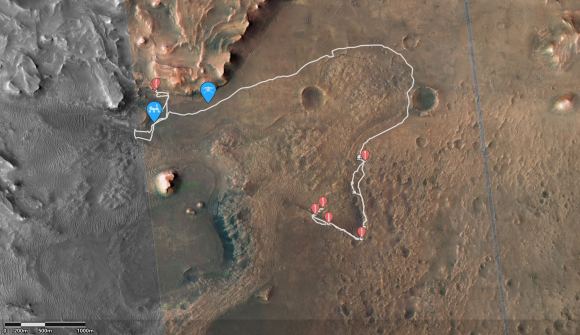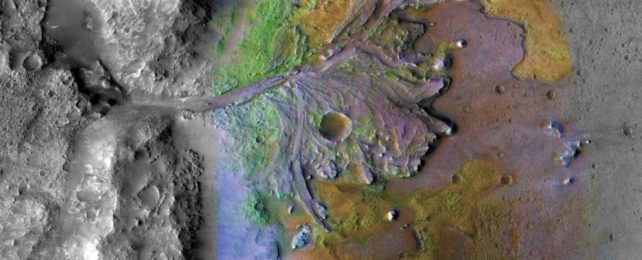The Perseverance rover is enjoying a bit of a winning streak lately!
For the past year and a half, the rover has been exploring the Jezero Crater on Mars to learn more about the planet's past.
As part of this mission, Perseverance is obtaining samples of Martian rock and soil that it will set aside in a cache for future retrieval. As part of a NASA/ESA sample-return mission, these will be returned to Earth for analysis and could contain evidence of past life.
Thanks to the international team of geologists and astrobiologists overseeing the collection process, the first of these rock samples have been obtained!
The team consisted of researchers from Caltech, the Lunar and Planetary Institute (LPI), NASA's Jet Propulsion Laboratory, the NASA Johnson Space Center, the Planetary Exploration Team at the Los Alamos National Laboratory, the Institut de Minéralogie, de Physique des Matériaux et de Cosmochimie, the Blue Marble Space Institute of Science (BMSIS), and multiple universities.
The paper that describes their findings, titled "Aqueously altered igneous rocks sampled on the floor of Jezero crater, Mars," recently appeared in the journal Science.
The samples were retrieved from the floor of the Jezero Crater, an ancient lakebed that once had water flowing into it. This is evident from the sedimentary deposits on the west side of the crater that were flow channels, as indicated by how they resemble a river delta.
This site was specifically chosen as the landing site for Perseverance because scientists believe that samples from these sedimentary deposits will reveal things about Mars' geological history.
This includes when (and for how long) the planet had flowing water on its surface – i.e., persistently or in short bursts – and how it transitioned to what we see today.
Even more tantalizing is the possibility that these samples will contain evidence of past life on Mars, which could have emerged billions of years ago when Mars had a warmer, wetter climate.

Amy Williams, a professor of geology at UF, is one of the long-term planners for the Perseverance mission who helps determine where the rover will drill and what tests and samples to prioritize.
As she said in a recent UF News release:
"These kinds of environments on Earth are places where life thrives. The goal of exploring the Jezero delta and crater is to look in these once-habitable environments for rocks that might contain evidence of ancient life.
"We have organisms on Earth that live in very similar kinds of rocks. And the aqueous alteration of the minerals has the potential to record biosignatures."
Ever since it landed in February 2021, Perseverance has explored the crater floor using a suite of tools to analyze the geological features, the chemical composition of the rocks, and the subsurface structure.
So far, their results have confirmed that the environment is more complex than previously thought.
For instance, the team discovered that the crater floor had eroded more than anticipated over time and exposed igneous rocks that formed from magma and lava flows. Scientists expected that the crater floor would be covered in softer sedimentary rock, which was likely worn away over eons.
The presence of igneous rocks shed new light on the crater's formation and how it has evolved since. Said Bethany Ehlmann, a professor of planetary science and associate director of the Keck Institute for Space Studies (KISS) at Caltech (who was not part of the research team):
"The finding of igneous rocks in the floor of the crater says that Jezero is more complex than the model of a lake basin that is filling with sediments over time with the delta being the last landform. It says that the region has had a rich geological history that has had both igneous and sedimentary processes."
What's more, the igneous rocks that Perseverance has sampled so far show signs of mineral alteration by water and organic compounds. These and other findings support the theory that the Jezero Crater could have been habitable billions of years ago.
The rover is now surveying the river delta to collect additional samples for the Mars Sample Return Mission, which will consist of elements contributed by the European Space Agency (ESA) and NASA that will land on the surface of Mars, retrieve the sample cache, and return it to orbit where a spacecraft will rendezvous with it and carry the samples home.
These include the NASA-designed Sample Retrieval Lander (SLR), Mars Ascent Vehicle (MAV), and Capture, Containment, and Return System (CCRS); and an ESA-designed Sample Transfer Arm and Earth Return Orbiter (ERO).
This mission is currently under development and is tentatively scheduled to coincide with launch windows between the fall of 2027 and the summer of 2028. The mission will land near the Octavia E. Butler Landing site (where Perseverance landed in 2021) by 2029 and return the samples to Earth by 2033.

To date, the Perseverance rover has obtained thirteen samples from various locations within the crater (see map above). Once they are returned to Earth, scientists can conduct detailed studies that would be impossible by robotic missions.
While Perseverance and Curiosity are equipped with cutting-edge science instruments and onboard laboratories, the equipment necessary to conduct a very deep analysis is too heavy and cumbersome to transport to Mars.
The sample-return mission will be the first to transport rock and soil obtained directly from Mars back to Earth.
These studies include measuring the age of rock samples taken from the bottom of the crater, which are likely to predate the river delta and provide important information about the age of the lake.
In addition, scientists will be looking for signs of ancient life (aka. biosignatures), which are expected to consist of fossilized bacteria or organic molecules that form in the presence of life (assuming there's anything to be found at all).
Regardless of what these samples reveal, the results are sure to be nothing short of ground-breaking and could potentially revolutionize our understanding of Mars.
This article was originally published by Universe Today. Read the original article.
